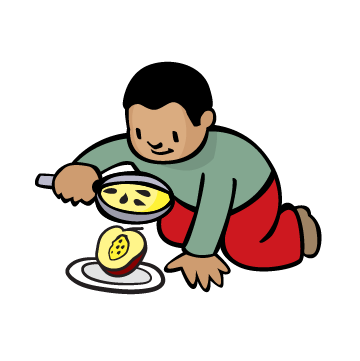Boston Children's Museum
308 Congress Street, Boston, MA 02210
617-426-6500
© Boston Children’s Museum 2025
Website Design by JackrabbitMost children only have a basic understanding of their own bodies, and they often have little choice about what they are served at meals. At the same time, these children are just becoming acquainted with a variety of foods. The more opportunities children have to think about what they eat, be curious and adventurous in trying new foods and begin to take responsibility for their own lifestyle choices, the more likely they are to make healthful choices when they do get to decide what fuel they are putting into their bodies. In this activity, children will learn how to read about the nutritional information for some of the foods they already eat. Learning to read these labels is one of the most helpful tools we have in gaining control of our eating habits.
It may take some time to gather the food containers. If you have a kitchen at your afterschool site, you might be able to pick and choose from there. More likely, it will be easiest for you to ask afterschool staff and kids to bring in empty food containers (with the labels on them!) from home. Try to gather some foods that children are already familiar with and some (especially from different cultures) that might be new to them. A total of 40–50 (or more) product packages will be needed for this activity.
Set up a shopping bags so that each team has a different bag to examine. Place a number of different products in each of the bags: soft drinks, cookies, cereal, fruit drinks, snacks, popcorn, pretzels, chips, granola bars, popsicles and anything else you can gather. Try to have a variety in each bag, especially a mix of foods that you might consider healthful and foods that you might consider to be “junk food”. Every bag does NOT need to have the same products as all the others.

Ask your students if their parents ever tell them not to eat too much of some things. What do they say? If there are foods that are “not that great” for us, how can we figure out which foods are better for us than others? How do we know what’s in packaged foods?
Investigate a shopping bag and decide which foods you think are good for you and which foods are not as healthful.
After each team has their food divided into the 3 categories, bring them together to discuss their findings. Make a list on a chalkboard or a piece of chart paper with 2 columns—”Good” and “Not So Good” (leave out the “Not Sure” foods for now). Ask each team to call out the foods they have put in each column. Write those product names down on the chart as the teams call them out.
When the chart is filled in by every team, ask if any students see anything in a column that they would change. Some students might disagree with other teams’ decisions. This is a great chance for debate! By talking about their differences of opinion, you can get kids to really focus on what determines if foods are good for you or if they aren’t. If a food is “challenged”, ask the team that is challenging why they think the food should be moved to a different column. Then ask the team who put it in the column to give the evidence from the nutritional label that helped them decide to categorize it the way that they did.
After having this discussion, focus on the foods that are in the “Not Sure” category. Ask teams to look at the nutritional information for these foods again and try to determine if they can place these foods into the “Good” or “Not So Good” column. What evidence does the nutritional label give them to help them decide? Are there any foods that simply don’t fit into the “Good” or “Not So Good” column?